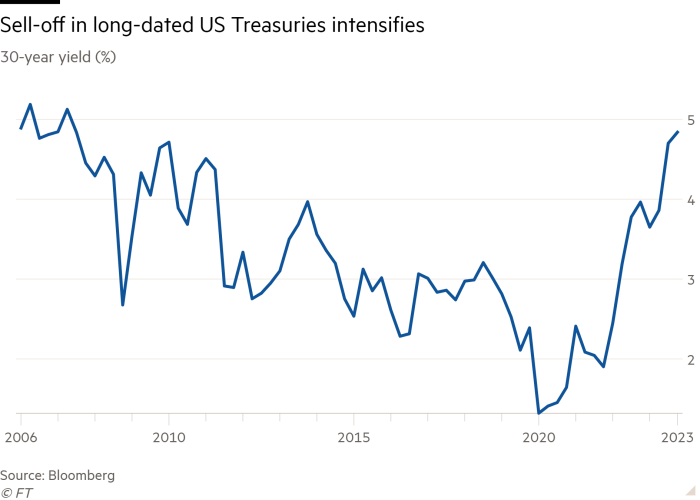
Receive free US Treasury bonds updates
We’ll send you a myFT Daily Digest email rounding up the latest US Treasury bonds news every morning.
The yield on 30-year US Treasuries hit a 16-year peak on Tuesday, as a sell-off in global bond markets pushed equities down and rocked currencies such as the yen and the rouble.
The 30-year US yield reached 4.95 per cent for the first time since 2007, before the financial crisis, as markets adjusted to the prospect of a long period of high interest rates and governments’ vast borrowing needs.
In a sign of the worldwide impact of the sell-off, German and Italian borrowing costs also hit their highest levels for more than a decade.
Stock markets fell on both sides of the Atlantic, while the yen briefly breached ¥150 to the dollar and the rouble weakened past 100 against the US currency.
The bond sell-off has followed a run of robust economic data and signalling by the US Federal Reserve that it will keep rates “higher for longer” to damp down demand and finish its job of vanquishing inflation.
“It’s a bond market selling off because of an underlying macro resilience and we see that in higher real rates,” said Padhraic Garvey, managing director at ING.
Among the data indicating the health of the US economy, manufacturing activity figures this week were better than expected. Job openings for US workers also unexpectedly rose in August, according to data released on Tuesday.
The rise of 0.15 percentage points in the 30-year yield came as the benchmark 10-year rose 0.12 percentage points to 4.8 per cent and the two-year edged higher.

Expectations that US interest rates will remain higher have boosted the dollar, heaping pressure on other currencies.
The yen rebounded following its breach of the politically sensitive ¥150 level after finance minister Shunichi Suzuki said the authorities were watching the market with a sense of urgency.
But the rouble sank below 100 to the dollar, despite recent Russian attempts to halt the currency’s decline by sharply increasing interest rates.
The shift in the $25tn US bond market has also triggered downturns in stocks and bonds across the globe.
The much-watched 30-year German yield rose 0.077 percentage points to 3.211 per cent, its highest level since 2011, while the Italian 30-year yield reached its highest level since 2012 at 5.45 per cent.
“There’s a bit of angst” over Italy’s budget deficit projections Garvey said, while adding: “I don’t think it’s a screaming crisis . . . the market is not panicking but looking at the risks.”
In the UK, the 30-year gilt yield passed 5 per cent this week, reaching its highest since the aftermath of former prime minister Liz Truss’s ill-fated “mini” Budget before falling back again to 4.99 per cent on Tuesday.
Stock markets weakened. Wall Street’s tech-heavy Nasdaq Composite was down more than 2 per cent in afternoon trading in New York, and on track for its biggest one-day drop in two months, while the broader S&P 500 fell 1.6 per cent. Europe’s region-wide Stoxx 600 index declined 1.1 per cent.
The turmoil in debt markets has affected equities by raising the returns that investors can lock in by buying bonds rather than stocks.
The bond sell-off has intensified following the Fed’s September meeting, which made clear the central bank’s intention to keep rates higher next year and in 2025 than the markets had expected.
Futures market traders are betting that by the end of next year US benchmark rates will have been cut twice or three times from their current range of 5.25 to 5.5 per cent. Before the Fed meeting, traders assumed four or five cuts by that time.
Government borrowing needs on both sides of the Atlantic have also pushed up yields.
“The US is running a budget deficit of 7 per cent — for [a] non recessionary period that’s very high,” said Jim Leaviss, fund manager at M&G, the asset manager.
“When governments are demanding and needing more money, bond yields have to rise to deal with that.”
The US Treasury planned to issue about $1tn in debt during the three months to the end of September, the first increase in its quarterly borrowing plans in two and a half years.
Additional reporting by Harriet Clarfelt in New York